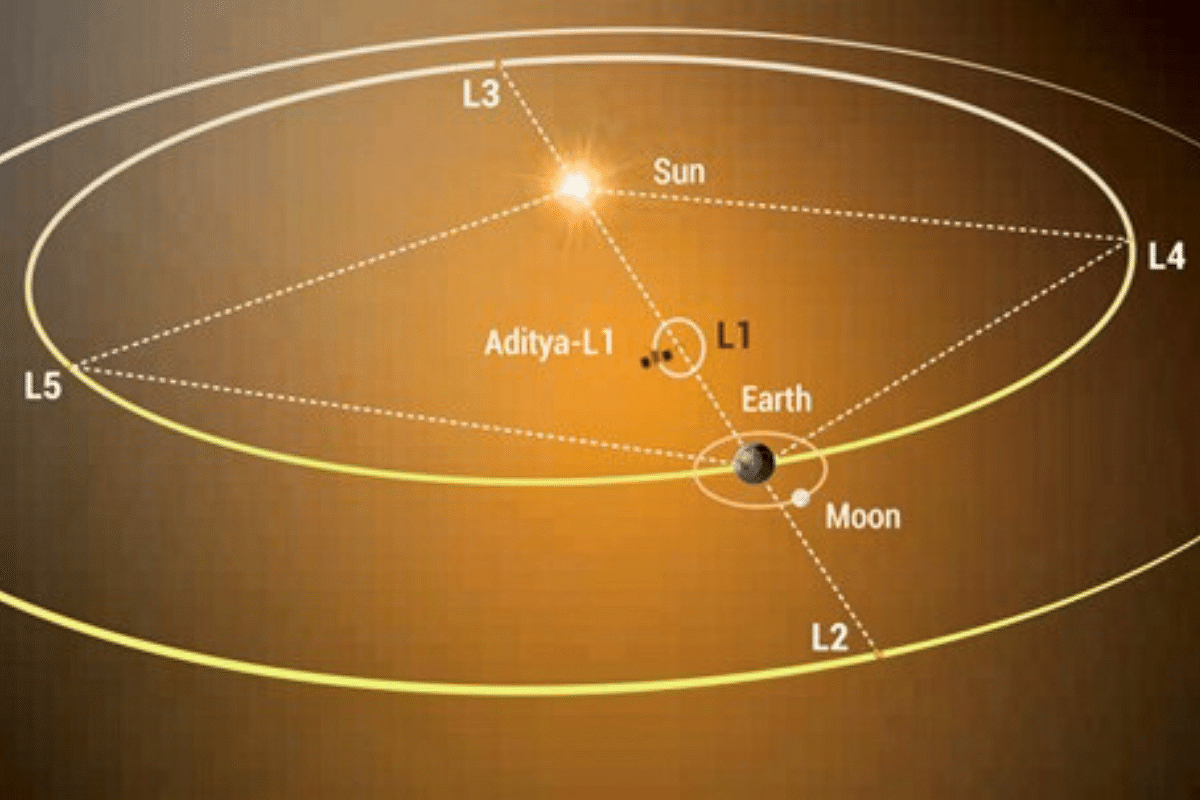Science
Aditya-L1: Flying To L1 Is Tricky, But ISRO's New Software Is Trained For The Job
- An L1 mission requires precise manoeuvres to reach the destination point as well as remain there.
- The room for error is very small when operating a spacecraft at L1.

Depiction of Aditya-L1 along with the five Lagrange points of the Sun-Earth system (Illustration: ISRO)
India's solar observatory, Aditya-L1, flew on a polar satellite launch vehicle (PSLV-XL) on Saturday (2 September) to reach Earth orbit.
The spacecraft is set to remain in Earth-bound orbits for 16 days, until about 18 September.
During this period, Aditya-L1 will be put in increasingly elliptical orbits through five manoeuvres to achieve the velocity necessary for a kick off to its destination, the Lagrange point 1 (L1) of the Sun-Earth system.
L1 is a gravitational sweet spot between Earth and the Sun located about 15 lakh kilometres away (L1 explained here).
The Indian Space Research Organisation (ISRO) is flying to L1 for the very first time.
According to the European Space Agency (ESA), "Lagrange point 1 is a tricky place to fly spacecraft."
ESA knows a thing or two about flying to L1. The Solar Heliospheric Observatory (SOHO), a joint ESA-NASA mission, has been stationed at L1 since 1996.
ESA's LISA Pathfinder spacecraft, too, flew to L1 in 2016. It was a technology demonstration mission seeking to pave the way for a future gravitational space observatory.
Even just earlier this year, ESA executed a Lagrange point mission by launching and deploying the Euclid spacecraft at L2 to probe the dark universe — dark matter and dark energy.
The space agency performed a 'transfer manoeuvre' on their Euclid mission similar to one that will come into play in the Aditya-L1 mission.
In their posts on X and their blog, ESA has shared about the challenges of an L1 mission and how they have supported ISRO with Aditya-L1.
"Getting there requires a complex transfer manoeuvre, and staying there requires regular manoeuvres to maintain the halo orbit," the agency said.
L1, one of the five Lagrange points of the Sun-Earth system, happens to be an 'unstable' point. The other such points are L2 and L3.
A spacecraft in an orbit around any of these 'unstable' points requires regular manoeuvres to correct its trajectory.
The L4 and L5 points, on the other hand, are considered 'stable' (provided a certain mass ratio is met).
"The L1 and L2 points are unstable on a time scale of approximately 23 days," NASA says, "which requires satellites orbiting these positions to undergo regular course and attitude corrections."
An L1 mission, thus, requires precise manoeuvres to reach the destination point as well as remain there. The room for error is very small when operating a spacecraft at L1.
Operators in charge of the mission have the tough task of staying on top of the spacecraft location at all times. This requires 'orbit determination' based on mathematical computation of tracking data.
ESA revealed that ISRO developed new orbit determination software for the Aditya-L1 mission and sought their help to improve the software using both training and real data.
"ESA has experience flying and even rescuing missions at Lagrange points, so we were in the perfect position to help," the agency said.
Experts from ESA and NASA had successfully 'rescued' the SOHO spacecraft after it had broken loose from its orbit after trajectory errors grew, and lost contact with ground stations.
SOHO was resuscitated and remains in orbit around L1 to this day.
ISRO sought out ESA's crucial experience for its Aditya-L1 mission, just as ESA had once sought out NASA's help with some of its early deep space missions.
Last year, ESA and ISRO joined forces from April to December to test out the new ISRO orbit determination software using both simulated data as well as real data from the LISA Pathfinder spacecraft at L1.
They identified areas of improvement for the software. According to ESA, "Both teams learned a lot and are confident in the capabilities of ISRO’s new software."
Additionally, ESA is supporting Aditya-L1 by providing deep space communication services to the mission.
All three of the agency's 35-metre deep space antennas in Australia, Spain, and Argentina, along with their Kourou station in French Guiana, are supporting India's space-based solar mission.
Aditya-L1 is set to join other solar spacecraft such as SOHO and the Solar Orbiter in a mission to advance solar science.
Support Swarajya's 50 Ground Reports Project & Sponsor A Story
Every general election Swarajya does a 50 ground reports project.
Aimed only at serious readers and those who appreciate the nuances of political undercurrents, the project provides a sense of India's electoral landscape. As you know, these reports are produced after considerable investment of travel, time and effort on the ground.
This time too we've kicked off the project in style and have covered over 30 constituencies already. If you're someone who appreciates such work and have enjoyed our coverage please consider sponsoring a ground report for just Rs 2999 to Rs 19,999 - it goes a long way in helping us produce more quality reportage.
You can also back this project by becoming a subscriber for as little as Rs 999 - so do click on this links and choose a plan that suits you and back us.
Click below to contribute.
Latest